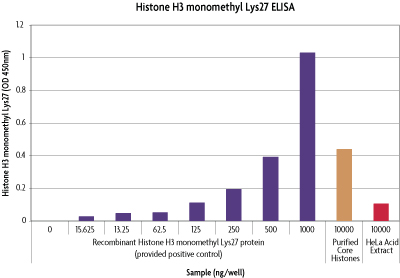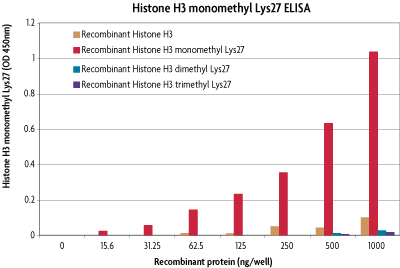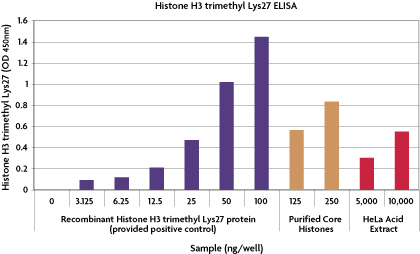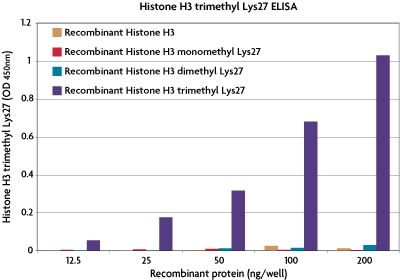Histone Modification ELISAs provide a simple, sensitive method for detecting changes in specific histone modifications from purified core histones or histones isolated by acid extraction. These kits are sandwich ELISAs that utilize a capture antibody against histone H3 and a primary antibody specifc for the modification of interest. A secondary antibody conjugated to horseradish peroxidase (HRP) and developing solutions provide a sensitive colorimetric readout that is easily quantified by spectrophotometry. The assay is performed in a convenient 96-stripwell plate, enabling low or high throughput screening. For complete details, click the ELISA Method tab below.
Histone H3 lysine 27 methylation (H3K27) ELISA
Histone H3 lysine 27 methylation ELISA kits provide everything needed for screening the levels of histone H3 mono- or trimethyl Lys 27 in human, mouse, rat and other (wide range predicted) systems. Histone H3 lysine 27 methylation (H3K27) has been correlated with heterochromatin formation and transcriptional repression, making the methylation state of lysine 27 an interesting marker of transcriptional activity. The methylation specific histone H3 antibodies will not cross-react with other site- or degree-specific methylated histones, enabling small changes in methylation levels to be detected. For added convenience and a more quantitative interpretation of results, the Histone Modification ELISAs also include a site- and degree-specific methylated recombinant histone protein for use as a reference standard curve. Click the H3K27 Info tab below for data and more information; kit manuals can be downloaded under the Documents tab.
| Name | Format | Cat No. | Price | |
|---|---|---|---|---|
| Histone H3 monomethyl Lys27 ELISA | 1 x 96 rxns | 53104 | $635 | Buy |
| Histone H3 trimethyl Lys27 ELISA | 1 x 96 rxns | 53106 | $635 | Buy |
| Histone H3 methylated Lys27 ELISA manual |
| Histone Analysis Products Profile |
| Histone Modifications Guide |
| Epigenetics Products and Services |
| Tools for Disease Research |
Histone H3 methylated Lys27 (H3K27)
The methylation of lysine 27 on histone H3 (H3K27) has been correlated with the regulation of gene transcription, making methylated lysine 27 on histone H3 a significant marker in studying the state of transcription activity. Methylation of histone H3 at lysine 27 is linked to heterochromatin formation and transcriptional repression. Polycomb group complexes PRC2 and PRC3, which play a role in proper embryonic development, are both involved involved in the methylation of lysine 27 on histone H3. Supressor of Zeste-12 protein (Suz12), when bound to its target promoter, enables EZH2 to trimethylate histone H3 on lysine 27.
Histone H3 monomethyl Lys27 ELISA
The Histone H3 monomethyl Lys27 ELISA is capable of detecting the level of histone H3 monomethylated at lysine 27 from core histone preparations or histones purified by acid extraction from tissue or cell samples (Figure 1). The Histone H3 monomethyl Lys27 sandwich ELISA assay is also tested for cross-reactivity with other degree-specific recombinant proteins as shown in Figure 2.

Figure 1: Histone H3 monomethyl Lys27 ELISA (H3K27).
The Histone H3 monomethyl Lys27 ELISA was used to assay purified HeLa core histones (10 µg) made using Active Motif's Histone Purification Mini Kit (Catalog No. 40026) and HeLa acid extracts (10 µg). The provided Recombinant Histone H3 monomethyl Lys27 protein was assayed from 15.6 - 1000 ng/well as a reference standard curve. Data shown are the results from wells assayed in duplicate. These results are provided for demonstration only.

Figure 2: Specificity of the Histone H3 monomethyl Lys27 ELISA (H3K27).
Recombinant Histone H3, mono-, di- and trimethyl Lys27 proteins were assayed from 15 ng - 1 µg per well using the Histone H3 monomethyl Lys27 ELISA. These results indicate the specificity of the assay. There is extremely low background from histone H3 and little cross-reactivity for di- or trimethyl Lys27. This means that small, specific changes in monomethyl Lys27 levels can easily be detected with this kit.
Histone H3 trimethyl Lys27 ELISA (H3K27me3)
The Histone H3 trimethyl Lys27 ELISA is capable of detecting the level of histone H3 trimethylated at lysine 27 from core histone preparations or histones purified by acid extraction from tissue or cell samples (Figure 1). The Histone H3 trimethyl Lys27 sandwich ELISA assay is also tested for cross-reactivity with other degree-specific recombinant proteins as shown in Figure 2.

Figure 1: Histone H3 trimethyl Lys27 ELISA (H3K27me3).
The Histone H3 trimethyl Lys27 ELISA was used to assay purified HeLa core histones (125 - 250 ng) made using Active Motif's Histone Purification Mini Kit (Catalog No. 40026) and HeLa acid extracts (5 - 10 µg). The provided Recombinant Histone H3 trimethyl Lys27 protein was assayed from 3.125 - 100 ng/well as a reference standard curve. Data shown are the results from wells assayed in duplicate. These results are provided for demonstration only.

Figure 2: Specificity of the Histone H3 trimethyl Lys27 ELISA (H3K27me3).
Recombinant Histone H3, mono-, di- and trimethyl Lys27 proteins were assayed from 15 ng - 1 µg per well using the Histone H3 trimethyl Lys27 ELISA. These results indicate the specificity of the assay. There is extremely low background from histone H3 and little cross-reactivity for mono- or dimethyl Lys27. This means that small, specific changes in trimethyl Lys27 levels can easily be detected with this kit.
The Histone Modification ELISA Advantage
Historically, screening for histone modifications from sample preparations have been conducted using immunoblotting and chromatin immunoprecipitation methods, which can be time-consuming, do not allow for high-throughput and provide only semi-quantitative results. Active Motif's Histone Modification ELISAs provide a fast, sensitive assay with the flexibility to screen from 1 to 96 samples in a single experiment.
Included in each Histone Acetylation ELISA is an acetylated recombinant histone protein made using Active Motif's patented protein synthesis technology. Likewise, included in each Histone Methylation ELISA is a methylated recombinant histone protein made using Active Motif's patented protein synthesis technology. These included proteins can be used to build a reference standard curve to quantitate the amount of either specifically acetylated or methylated histone H3 (respectively) in your samples. Click on our link for more information on our patented protein synthesis technologies and to get a complete list of our Recombinant Histones and Modified Histones. The Total Histone H3 ELISA includes an unmodified Recombinant Histone H3 protein. Each Histone Phosphorylation ELISA contains treated and untreated acid extracts for use as a positive and negative controls.
Why use the Histone Methylation, Histone Acetylation and Histone Phosphorylation ELISAs?
- Increased sensitivity over immunoblotting methods
- Results in less than three hours
- Specific antibody detection ensures low background and no cross-reactivity with other modifications
- Colorimetric readout enables easy, quantitative analysis with spectrophotometry at 450 nm
- 96-stripwell format enables both high and low throughput
- Positive controls included in each kit
The Histone Acetylation ELISA Method
The Histone ELISAs to detect acetylation levels on histone H3 are sandwich ELISAs that utilize a monoclonal histone H3 antibody to capture histone H3 from purified core histones or histones isolated by acid extraction from tissue or cell samples. A polyclonal antibody specific for the modification of interest is used for detection, while a secondary antibody conjugated to horseradish peroxidase (HRP) and developing solutions provide a sensitive colorimetric readout that is easily quantified by spectrophotometry at 450 nm. The assay is performed in a convenient 96-stripwell plate, which enables either low or high throughput screening.
The Histone Methylation ELISA Method
The Histone ELISAs to detect site- and degree-specific lysine methylation levels on histone H3 are sandwich ELISAs that utilize a monoclonal histone H3 antibody to capture histone H3 from purified core histones or histones isolated by acid extraction from tissue or cell samples. A polyclonal antibody specific for the modification of interest is used for detection, while a secondary antibody conjugated to horseradish peroxidase (HRP) and developing solutions provide a sensitive colorimetric readout that is easily quantified by spectrophotometry at 450 nm. The assay is performed in a convenient 96-stripwell plate, which enables either low or high throughput screening.
The Histone Phosphorylation ELISA Method
The Histone ELISAs to detect phosphorylation levels of serine 10 (pSer10) or serine 28 (pSer28) on histone H3 are sandwich ELISAs that utilize a C-terminal histone H3 antibody to capture histone H3 from purified core histones or histones isolated by acid extraction from tissue or cell samples. A monoclonal antibody specific for the phosphorylation site of interest is used for detection, while a secondary antibody conjugated to horseradish peroxidase (HRP) and developing solutions provide a sensitive colorimetric readout that is easily quantified by spectrophotometry at 450 nm. The assay is performed in a convenient 96-stripwell plate, which enables either low or high throughput screening.
Flow Chart of Histone Modification ELISA Method
Figure 1: Flow chart of the Histone Modification ELISA Method.
Histone Modification ELISAs utilize a histone H3 antibody to capture histone H3 from samples and a modification specific antibody for detection. A secondary antibody conjugated to horseradish peroxidase and developing solutions provide a colorimetric readout that is quantified by spectrophotometry. (Click image to enlarge.)
Contents & Storage
Histone H3 monomethyl Lys27 ELISA Kits include a 96-stripwell Histone H3 Capture plate, a primary antibody specific for Histone H3 monomethyl Lys27, HRP-conjugated anti-rabbit IgG secondary antibody, Assay Dilution Buffer, 20X Wash Buffer, Developing Solution, Stop Solution, Recombinant Histone H3 monomethyl Lys27 positive control protein and plate sealer. Storage conditions vary from room temperature to -80°C, see manual for details. All reagents are guaranteed stable for 6 months when stored properly.
Histone H3 trimethyl Lys27 ELISA Kits include a 96-stripwell Histone H3 Capture plate, a primary antibody specific for Histone H3 trimethyl Lys27, HRP-conjugated anti-rabbit IgG secondary antibody, Assay Dilution Buffer, 20X Wash Buffer, Developing Solution, Stop Solution, Recombinant Histone H3 trimethyl Lys27 positive control protein and plate sealer. Storage conditions vary from room temperature to -80°C, see manual for details. All reagents are guaranteed stable for 6 months when stored properly.


